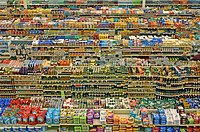
Critical review: Grand challenges in assessing the adverse effects of contaminants of emerging concern on aquatic food webs.
Sign Up to like & getrecommendations! Published in 2019 at "Environmental toxicology and chemistry"
DOI: 10.1002/etc.4290
Abstract: Much progress has been made in the past few decades in understanding the sources, transport, fate, and biological effects of contaminants of emerging concern (CECs) in aquatic ecosystems. Despite these advancements, significant obstacles still prevent… read more here.
Keywords: contaminants emerging; food webs; effects contaminants; emerging concern ... See more keywords

Identification and regulation of ecotoxicity of polychlorinated naphthalenes to aquatic food Chain (green algae-Daphnia magna-fish).
Sign Up to like & getrecommendations! Published in 2021 at "Aquatic toxicology"
DOI: 10.1016/j.aquatox.2021.105774
Abstract: Polychlorinated naphthalenes (PCNs) are widely distributed in the aquatic environment and can be transmitted through the food chain, which can amplify their toxic effects on human. To inhibit their transmission in the trophic level, this… read more here.
Keywords: food chain; toxicity; food; aquatic food ... See more keywords

Methylmercury biomagnification in coastal aquatic food webs from western Patagonia and western Antarctic Peninsula.
Sign Up to like & getrecommendations! Published in 2021 at "Chemosphere"
DOI: 10.1016/j.chemosphere.2020.128360
Abstract: Mercury (Hg) is a global pollutant of concern because its organic and more toxic form, methylHg (MeHg), bioaccumulates and biomagnifies through aquatic food webs to levels that affect the health of fish and fish consumers,… read more here.
Keywords: food webs; antarctic peninsula; mehg; food ... See more keywords

Multiple-stressor exposure of aquatic food webs: Nitrate and warming modulate the effect of pesticides.
Sign Up to like & getrecommendations! Published in 2022 at "Water research"
DOI: 10.1016/j.watres.2022.118325
Abstract: Shallow lakes provide essential ecological and environmental services but are exposed to multiple stressors, including agricultural runoff (ARO) and climate warming, which may act on different target receptors disrupting their normal functioning. We performed a… read more here.
Keywords: stressor exposure; exposure aquatic; multiple stressor; climate warming ... See more keywords

Current status of food safety hazards and health risks connected with aquatic food products from Southeast Asian region.
Sign Up to like & getrecommendations! Published in 2020 at "Critical reviews in food science and nutrition"
DOI: 10.1080/10408398.2020.1866490
Abstract: Food safety issues associated with aquatic food products become more important with the increasing consumption and followed by its ongoing challenges. The objective of this paper is to review the food safety hazards and health… read more here.
Keywords: food safety; food products; southeast asian; food ... See more keywords

Nanotechnology-based preservation approaches for aquatic food products: A review with the current knowledge.
Sign Up to like & getrecommendations! Published in 2022 at "Critical reviews in food science and nutrition"
DOI: 10.1080/10408398.2022.2096563
Abstract: Aquatic food products (AFPs) are primarily preferred by consumers due to their high-quality protein content, omega 3 fatty acids, vitamins, minerals, and low calories. However, AFPs are easily degraded by microbial, enzymatic, and chemical reactions.… read more here.
Keywords: nanotechnology; aquatic food; preservation approaches; food products ... See more keywords

Balancing Nutrition and Safety
Sign Up to like & getrecommendations! Published in 2018 at "Journal of Aquatic Food Product Technology"
DOI: 10.1080/10498850.2018.1445297
Abstract: It is a well-known fact that aquatic food is good for human nutrition. However, in some cases, the species used for consumption may contain toxic components produced by microorganisms or contaminants in the water; or… read more here.
Keywords: present issue; issue; safety; nutrition ... See more keywords

Cold plasma for the preservation of aquatic food products: An overview.
Sign Up to like & getrecommendations! Published in 2021 at "Comprehensive reviews in food science and food safety"
DOI: 10.1111/1541-4337.12815
Abstract: Cold plasma (CP) is an upcoming technology implemented for the preservation of highly perishable foods, especially aquatic food products (AFPs). The high moisture content, high-quality protein with all essential amino acids and unsaturated fatty acids… read more here.
Keywords: quality; food products; preservation; cold plasma ... See more keywords

Pressure-Induced Shifts in Trophic Linkages in a Simplified Aquatic Food Web
Sign Up to like & getrecommendations! Published in 2017 at "Frontiers in Environmental Science"
DOI: 10.3389/fenvs.2017.00075
Abstract: It is essential to understand effects of existing and emerging anthropogenic stressors on the structure of aquatic food webs in more natural settings, to obtain realistic predictions on how they can affect major ecosystem properties… read more here.
Keywords: shifts trophic; trophic linkages; food web; food ... See more keywords

Structure, Merits, Gel Formation, Gel Preparation and Functions of Konjac Glucomannan and Its Application in Aquatic Food Preservation
Sign Up to like & getrecommendations! Published in 2023 at "Foods"
DOI: 10.3390/foods12061215
Abstract: Konjac glucomannan (KGM) is a natural polysaccharide extracted from konjac tubers that has a topological structure composed of glucose and mannose. KGM can be used as a gel carrier to load active molecules in food… read more here.
Keywords: structure; food preservation; food; konjac glucomannan ... See more keywords

Mycotoxins in Seafood: Occurrence, Recent Development of Analytical Techniques and Future Challenges
Sign Up to like & getrecommendations! Published in 2023 at "Separations"
DOI: 10.3390/separations10030217
Abstract: The co-occurrence of mycotoxigenic fungi and mycotoxins in aquatic food commodities has recently become a source of severe worldwide food insecurity since these toxicants may damage human health. The consumption of aquatic food itself represents… read more here.
Keywords: food; seafood occurrence; mycotoxins seafood; aquatic food ... See more keywords